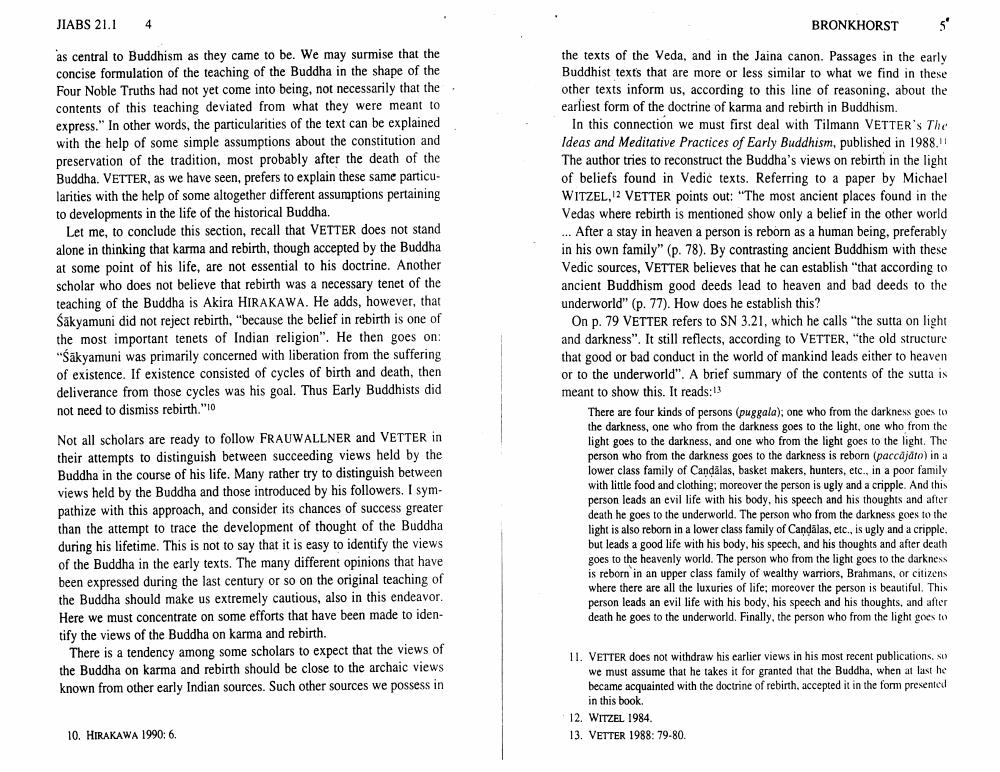Book Title: Did Buddha Believe In Karma And Rebirth Author(s): Johannes Bronkhorst Publisher: Johannes Bronkhorst View full book textPage 3
________________ JIABS 21.1 as central to Buddhism as they came to be. We may surmise that the concise formulation of the teaching of the Buddha in the shape of the Four Noble Truths had not yet come into being, not necessarily that the contents of this teaching deviated from what they were meant to express." In other words, the particularities of the text can be explained with the help of some simple assumptions about the constitution and preservation of the tradition, most probably after the death of the Buddha. VETTER, as we have seen, prefers to explain these same particularities with the help of some altogether different assumptions pertaining to developments in the life of the historical Buddha. Let me, to conclude this section, recall that VETTER does not stand alone in thinking that karma and rebirth, though accepted by the Buddha at some point of his life, are not essential to his doctrine. Another scholar who does not believe that rebirth was a necessary tenet of the teaching of the Buddha is Akira HIRAKAWA. He adds, however, that Šakyamuni did not reject rebirth, "because the belief in rebirth is one of the most important tenets of Indian religion". He then goes on: "Šakyamuni was primarily concerned with liberation from the suffering of existence. If existence consisted of cycles of birth and death, then deliverance from those cycles was his goal. Thus Early Buddhists did not need to dismiss rebirth."10 Not all scholars are ready to follow FRAUWALLNER and VETTER in their attempts to distinguish between succeeding views held by the Buddha in the course of his life. Many rather try to distinguish between views held by the Buddha and those introduced by his followers. I sympathize with this approach, and consider its chances of success greater than the attempt to trace the development of thought of the Buddha during his lifetime. This is not to say that it is easy to identify the views of the Buddha in the early texts. The many different opinions that have been expressed during the last century or so on the original teaching of the Buddha should make us extremely cautious, also in this endeavor. Here we must concentrate on some efforts that have been made to identify the views of the Buddha on karma and rebirth. There is a tendency among some scholars to expect that the views of the Buddha on karma and rebirth should be close to the archaic views. known from other early Indian sources. Such other sources we possess in 10. HIRAKAWA 1990: 6. BRONKHORST the texts of the Veda, and in the Jaina canon. Passages in the early Buddhist texts that are more or less similar to what we find in these. other texts inform us, according to this line of reasoning, about the earliest form of the doctrine of karma and rebirth in Buddhism. In this connection we must first deal with Tilmann VETTER's The Ideas and Meditative Practices of Early Buddhism, published in 1988.!! The author tries to reconstruct the Buddha's views on rebirth in the light of beliefs found in Vedic texts. Referring to a paper by Michael. WITZEL,12 VETTER points out: "The most ancient places found in the Vedas where rebirth is mentioned show only a belief in the other world ... After a stay in heaven a person is reborn as a human being, preferably in his own family" (p. 78). By contrasting ancient Buddhism with these Vedic sources, VETTER believes that he can establish "that according to ancient Buddhism good deeds lead to heaven and bad deeds to the underworld" (p. 77). How does he establish this? On p. 79 VETTER refers to SN 3.21, which he calls "the sutta on light and darkness". It still reflects, according to VETTER, "the old structure that good or bad conduct in the world of mankind leads either to heaven or to the underworld". A brief summary of the contents of the sutta is meant to show this. It reads:13 There are four kinds of persons (puggala); one who from the darkness goes to the darkness, one who from the darkness goes to the light, one who from the light goes to the darkness, and one who from the light goes to the light. The person who from the darkness goes to the darkness is reborn (paccājāto) in a lower class family of Candalas, basket makers, hunters, etc., in a poor family with little food and clothing; moreover the person is ugly and a cripple. And this person leads an evil life with his body, his speech and his thoughts and after death he goes to the underworld. The person who from the darkness goes to the light is also reborn in a lower class family of Candālas, etc., is ugly and a cripple, but leads a good life with his body, his speech, and his thoughts and after death goes to the heavenly world. The person who from the light goes to the darkness is reborn in an upper class family of wealthy warriors, Brahmans, or citizens where there are all the luxuries of life; moreover the person is beautiful. This person leads an evil life with his body, his speech and his thoughts, and after death he goes to the underworld. Finally, the person who from the light goes to 11. VETTER does not withdraw his earlier views in his most recent publications, so we must assume that he takes it for granted that the Buddha, when at last he became acquainted with the doctrine of rebirth, accepted it in the form presented in this book. 12. WITZEL 1984. 13. VETTER 1988: 79-80.Page Navigation
1 2 3 4 5 6 7 8 9 10
